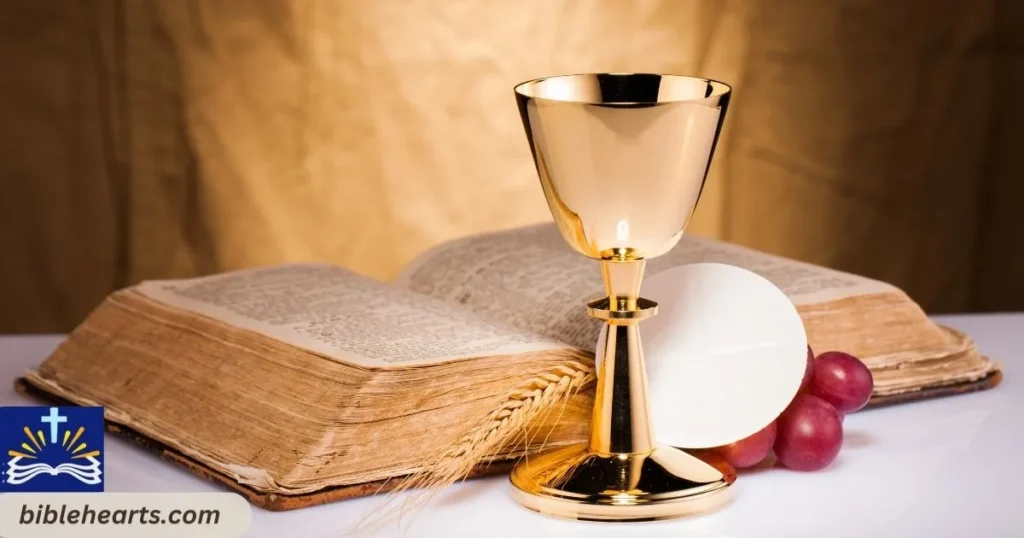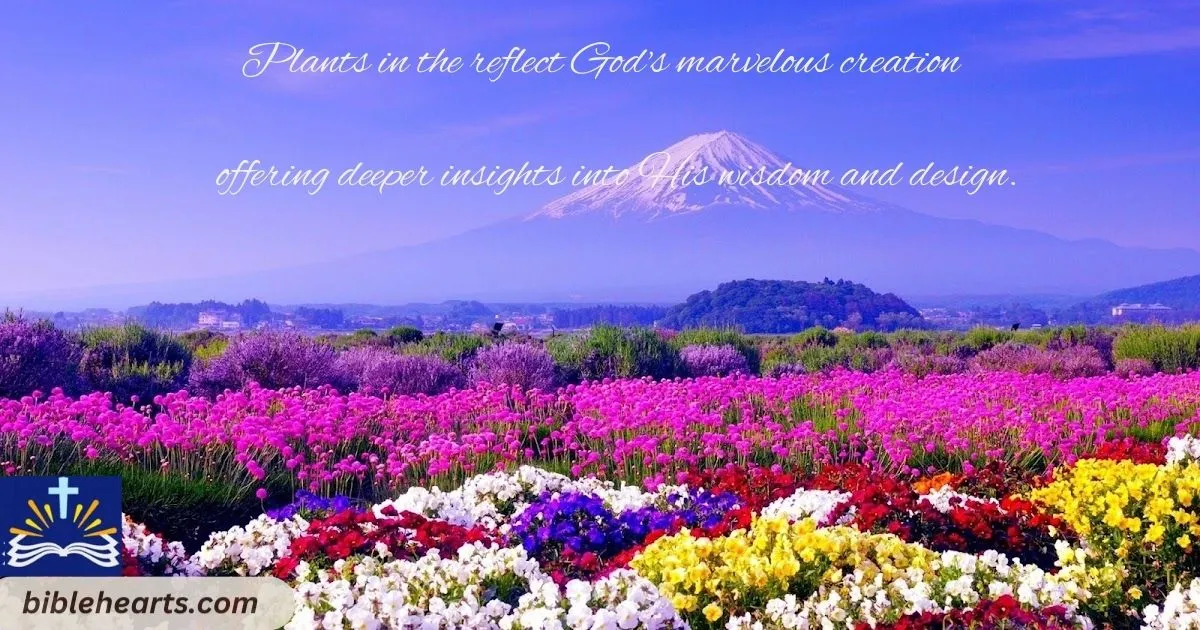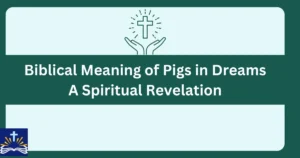Plants in the Bible reflect God’s marvelous creation, offering deeper insights into His wisdom and design.
The beauty of nature has always captivated human hearts, especially when we consider the way plants and trees are portrayed in the Bible. In many verses, plants are used as symbols to illustrate deeper truths about life, faith, and God’s provision. They stand as powerful reminders of the wonders of creation, inviting us to reflect on the spiritual truths they represent. The Bible uses plants to communicate God’s goodness, His wisdom, and the way He nurtures His creation.
Not only are plants featured throughout the scriptures as symbols of growth and prosperity, but they are also used to teach lessons about faith, obedience, resilience, and endurance. By examining these biblical references, we can gain a deeper understanding of how plants highlight the beauty of creation and the intricate design of God’s plan for the world. These references to plants help us appreciate the connections between our own lives and the world around us.
In this post, we will explore key Bible verses that highlight plants as a way of reflecting God’s creation. We will delve into their meanings, the spiritual lessons they teach, and how they point us toward the beauty of life itself. From the deep roots of faith to the flourishing growth of obedience, we will examine how plants in the Bible serve as powerful metaphors that enrich our understanding of God’s love for us.
Plants as Symbols of Growth and Prosperity
Psalm 1:3
In Psalm 1:3, the righteous are compared to a tree planted by streams of water. This verse symbolizes stability and prosperity. Just as a tree by the water thrives, so does a person rooted in God’s Word and guidance. The imagery of a well-watered plant signifies growth and fruitfulness that comes from staying connected to God’s truth. The verse invites believers to be like the tree that does not wither, flourishing because it is nourished by the eternal source.
Jeremiah 17:8
Jeremiah 17:8 continues the theme of a plant rooted by water, offering a beautiful picture of resilience and trust. The verse speaks of someone who trusts in God, saying that they will be like a tree planted by the water. This tree will not fear the heat or drought, and it will remain green, signifying the strength and prosperity of those who remain faithful to God. The plant here symbolizes unwavering trust in God’s provision, even in difficult circumstances.
John 15:5

In John 15:5, Jesus uses the metaphor of a vine and branches to describe the relationship between Himself and His followers. He says, “I am the vine; you are the branches.” This verse emphasizes that true growth and prosperity in life come only from remaining connected to Jesus. Just as a branch cannot bear fruit apart from the vine, believers cannot bear fruit apart from Christ. The metaphor of the vine highlights the spiritual connection necessary for true growth and fruitfulness.
Isaiah 61:3
Isaiah 61:3 presents a vision of transformation, where the Lord promises to provide “beauty for ashes,” symbolizing how God restores and enriches His people. The verse mentions planting “oaks of righteousness,” symbolizing strength, stability, and prosperity. The planting of oaks highlights how God’s restorative work brings lasting change, making His people strong and fruitful, just as plants thrive in fertile ground.
Matthew 13:31-32
In Matthew 13:31-32, Jesus shares the parable of the mustard seed, where He likens the kingdom of God to a small mustard seed that grows into a large tree. This verse highlights the theme of growth and expansion, where something small and seemingly insignificant becomes a source of great shelter and blessings. The mustard seed represents how God’s kingdom, though it starts small, will grow and provide refuge and prosperity to many.
Plants as Metaphors for Faith and Obedience
Matthew 13:23
In Matthew 13:23, Jesus speaks about the parable of the sower, explaining how the seed sown on good soil represents those who hear the Word and understand it. The seed grows and bears fruit, illustrating how faith and obedience lead to spiritual growth. The plant here symbolizes the flourishing of faith in fertile hearts, where the Word of God takes root and produces good works.
Luke 8:15
Luke 8:15 echoes a similar sentiment to Matthew 13:23, where the good soil represents those who hear the Word, hold onto it, and produce a fruitful life. This metaphor emphasizes the connection between obedience to God’s Word and the resulting growth in a believer’s life. Just like a plant that thrives with proper care, faith grows through diligent obedience to God’s commands.
1 Corinthians 3:6-7
In 1 Corinthians 3:6-7, Paul compares the work of spreading the Gospel to planting and watering. He acknowledges that while one plants and another waters, it is God who causes the growth. This passage emphasizes the role of faith and obedience in the process of spiritual growth, acknowledging that God is ultimately the one who nurtures and causes increase.
James 3:18
James 3:18 highlights the “fruit of righteousness” that is sown in peace by those who make peace. This verse connects the concept of plants with the idea of cultivating peace and righteousness. The plant here symbolizes the results of obedient living and the growth that comes from pursuing peace and righteousness in God’s way.
Galatians 6:7
Galatians 6:7 reminds us that we reap what we sow. This verse highlights the principle of cause and effect in the spiritual realm, where sowing seeds of obedience leads to a harvest of righteousness. Like a plant growing from a seed, our actions, whether good or bad, will result in a corresponding outcome.
Plants as Illustrations of God’s Provision
Genesis 1:29
In Genesis 1:29, God provides plants as food for humanity. The verse highlights God’s provision for His creation, giving plants as a means of sustenance. This is a clear demonstration of God’s care for His people, ensuring that their physical needs are met through the abundance of plant life.
Deuteronomy 8:8
Deuteronomy 8:8 describes the fertile land God promised to give His people, including abundant crops like wheat, barley, and figs. This verse underscores how God provides for His people, offering an abundance of natural resources. Plants symbolize the richness of God’s provision, ensuring that His people lack nothing.
Psalm 104:14
Psalm 104:14 speaks of God’s provision of plants for food, sustenance, and even beauty. The verse acknowledges that God causes the earth to produce plants, which provide nourishment for both animals and humans. The flourishing of plants demonstrates God’s ongoing care for creation, allowing it to thrive.
Isaiah 55:10-11
Isaiah 55:10-11 draws a parallel between rain, snow, and the Word of God, showing that just as rain nourishes the earth, God’s Word nourishes the hearts of His people. The verse suggests that God’s provision is not just physical but also spiritual, as His Word brings life and growth to His followers.
Matthew 6:28-30
In Matthew 6:28-30, Jesus points to the lilies of the field, which are beautifully clothed by God, as a reminder that God will provide for our needs. The flowers of the field are a symbol of God’s provision and care, reminding us to trust in His faithfulness to meet our needs without worry.
Bible Verses About Equality in God’s Vision
Plants as Examples of Resilience and Endurance
Job 14:7-9
Job 14:7-9 compares the hope of a tree sprouting again to the resilience of faith. Even when a tree is cut down, it has the potential to sprout again if its roots remain strong. This illustrates the power of endurance and the hope that God provides, even when life seems barren. Just as a tree can regenerate, so too can faith revive in difficult circumstances.
Isaiah 40:8
Isaiah 40:8 declares that “the grass withers and the flowers fall, but the Word of our God endures forever.” This verse highlights the temporary nature of earthly things and the eternal nature of God’s Word. Plants, though they may wither, remind us of the enduring nature of God’s promises.
Psalm 92:12
Psalm 92:12 compares the righteous to a flourishing palm tree, which remains strong and enduring despite challenges. The plant here symbolizes resilience, showing that those who follow God can stand firm, enduring through life’s difficulties.
Hosea 14:5-6
Hosea 14:5-6 uses the metaphor of the blossoming lily and the spreading of roots to illustrate how God’s people will thrive and endure. This passage emphasizes the regenerative power of God’s grace, which causes His people to grow strong and resilient, even in adverse conditions.
Matthew 13:33
In Matthew 13:33, Jesus tells the parable of the yeast, comparing it to the Kingdom of God. The yeast, though small, spreads and affects the whole batch of dough. This illustrates the enduring and spreading nature of God’s Kingdom, showing how small acts of faith can have lasting impacts.
Plants as Representations of God’s Wisdom and Design
Proverbs 3:18

Proverbs 3:18 refers to wisdom as a tree of life to those who take hold of it. Just as a tree provides nourishment and shelter, so does wisdom. The plant here symbolizes the richness that wisdom brings, offering both beauty and sustenance in life.
Proverbs 11:30
Proverbs 11:30 speaks of the righteous bearing fruit, symbolizing the positive results of living in alignment with God’s wisdom. This plant metaphor illustrates the connection between God’s wisdom and a fruitful, meaningful life.
Song of Solomon 2:12
In Song of Solomon 2:12, the plants of the field are described as blossoming, symbolizing the beauty and vitality that love and divine wisdom bring. The imagery of flourishing plants serves as a metaphor for the blossoming of God’s presence and wisdom in the lives of His people.
Isaiah 35:1
Isaiah 35:1 speaks of the desert blooming with flowers, symbolizing how God’s wisdom and design can transform even the most barren places into places of life and beauty. The plants in this passage reflect the transformative power of God’s work in the world.
Matthew 6:28
Matthew 6:28 calls attention to the lilies of the field, which are beautifully clothed by God. This verse reminds us that God’s design is perfect, as He provides beauty in nature with great care. The lilies symbolize God’s wisdom in creation, showing that He takes care of even the smallest details.
What Does the Bible Say About Plants Highlighting Creation’s Beauty?
The Bible uses plants not only as symbols of faith and growth but also as reflections of God’s beauty in creation. Through the imagery of trees, flowers, and seeds, we see the intricate design and wisdom that God has woven into nature.
These plants serve as a constant reminder of the beauty, stability, and nourishment that God provides for all creation.
Key Insight
1. What is the spiritual meaning of plants in the Bible?
Plants in the Bible represent spiritual growth, faith, and God’s provision. They are symbols of resilience, endurance, and obedience, illustrating how believers can flourish in their faith by staying connected to God’s Word.
2. How can the Bible’s references to plants inspire my faith?
The Bible’s references to plants inspire faith by showing that just as plants grow, bear fruit, and withstand harsh conditions, so can we grow spiritually by trusting in God’s guidance and provision.
3. Why does the Bible compare people to trees and plants?
The Bible compares people to trees and plants to symbolize growth, resilience, and faithfulness. Just like trees bear fruit, believers are called to bear good fruit in their lives through obedience to God.
4. How can plants symbolize God’s wisdom in creation?
Plants symbolize God’s wisdom by demonstrating His perfect design in creation. Each plant serves a purpose, showing how God’s wisdom is reflected in the intricate details of nature.
5. What does the Bible teach about God’s provision through plants?
The Bible teaches that God provides for His people through plants, supplying them with nourishment and beauty. Plants serve as a reminder of God’s care and provision for all of creation.
Conclusion:
Plants in the Bible are not just physical entities—they carry deep spiritual significance. From symbols of growth and prosperity to representations of God’s provision, resilience, and wisdom, plants highlight the beauty of creation in many ways.
They remind us of the intricate design of the world and encourage us to reflect on how God nurtures and sustains both nature and our spiritual lives. By meditating on these biblical references, we can draw closer to understanding God’s purpose and His work in the world around us.

Hi! I’m Isabel, a passionate writer who loves exploring the beauty of everyday life through heartfelt stories and vibrant poetry.










